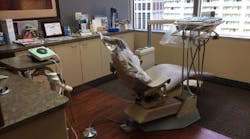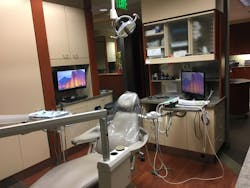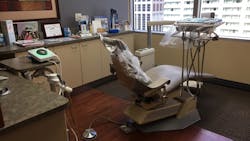RDH Editors
Paige Cowan Seaborg, RDH, has a knockout view of the Seattle skyline. Her building, One Union Square, is at the heart of the vibrant Seattle downtown. Her operatory offers a tall wall of windows overlooking the city center. For the last 13 years, Paige and her patients have enjoyed the view of the skyline and a landscaped plaza below, which changes colors with the seasons. But according to Paige, it’s not just the scenery changes. “Our practice is always evolving,” she says.
Patient comfort is as important as the stunning view that surrounds patients. “As they sit in the chair and lie back, they can watch the ever-changing Seattle sky and clouds. We have plush blankets for anyone who wants one.” Patient comfort also means making the prophy experience as relaxing as possible.
The operatory of Paige Cowan Seaborg, RDH
Paige looks to products with arginine to help with sensitivity issues. “I have been using arginine desensitizing products for many years with great success,” she says. “I used DenClude prior to Colgate Pro-Relief. When a patient has sensitivity in recession areas, I polish the paste on all sites and let it sit. As I use the piezo, it washes away the paste.” She estimates 99% relief from discomfort related to scaling or temperature.
Paige says her patients love her piezo. “It offers easy access and use. Patients love the low water and quieter function than other ultrasonics.” A ReLeaf hands-free suction device has recently been added to her operatory as a trial, and she is finding it helpful when using the piezo. “ReLeaf has been helpful in most situations,” she says. “Patient acceptance is good. It allows freedom from constantly handling the suction and ergonomic stress.”
For diagnostic assistance, Paige recommends the DEXIS CariVu. “I love using the CariVu. It diagnoses and helps patients understand when incipient decay has advanced to needing treatment, as well as visualizes cracks and sees those older alloys. CariVu images are quick and insightful. The unit and a sterile sleeve are behind me. I put them together, open the DEXIS window, dry the tooth, place the sensor, and take an image from the occlusal aspect of the tooth. The tooth is transilluminated, showing cracks, occlusal and interproximal decay, as well as failing margins of restorations on the occlusal surface. It’s easy for the patent to interpret and process the pathology. I show them what I see and let the dentist diagnose.” She adds, “This year, the practice is adding Digital Doc to take photos of teeth.”
One Union Square in downtown Seattle, Washington
Paige looks to ensure her own comfort and ergonomic support by using Orascoptic loupes and a Crown Seating Virtu operator chair. “I have been practicing 40 years. We moved into this space about 12 years ago. My dentist listened to my input in design, with instruments to my right rather than rear delivery.”
Paige noticed a change of computer monitor was needed, as it was placed behind the clinician. “I needed a monitor that I could see while I was working!” she exclaims. A second monitor was added to her counter. “My keyboard and mouse are wireless, allowing me to move them to the counter to my left and input data while probing, or change the image on the screen.”
From the operatory, patients have a view of the courtyard below, which changes colors with the seasons.
She also selected the operatory she wanted, which allowed her more storage options for toothbrushes and space for product displays. Paige usually recommends a sonic brush and interproximal cleaners to her patients. “Something to clean between the teeth could be floss, Proxabrush, Soft-Picks, Waterpik, etc. I love the Gum Technique and Summit toothbrushes,” she says.
“My operatory is my space, very flexible,” she says. We could also add “beautiful” and “completely comfortable” for patient and practitioner alike. Thanks for sharing your op with us, Paige!










